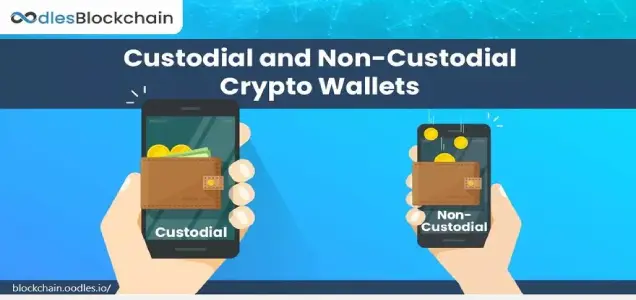-
Cryptocurrencies and their underlying technology, Blockchain, have gained significant traction in the tech world in the last few years. Both developers and investors are showing a keen interest in incorporating these two emerging concepts into their business processes. They can relish better opportunities compared to those offered by the traditional currency models. One business model that has emerged as an ideal solution is the use of cryptocurrency wallet development. These days the debate is about how to choose the right wallet according to the custody of private keys. We will discuss in detail in this article whether to choose custodial or non-custodial crypto wallets.
Custodial Wallets
In a custodial wallet, a third party holds private keys. It means it gets complete control over crypto-assets while a user can only make permission to send or receive payments.
Workings of a Custodial Wallet
Essentially, in a custodial wallet, a third-party authority manages all the funding while users cannot execute any transaction without their involvement.
For instance, Bob (a third party in this case) manages a fund transfer request made by Alice (a user in this case) to a particular address/place. However, Bob does not receive any private key to that specific storage address.
Advantages of Custodial Wallets
Cost-effective Transactions
A custodial wallet, unlike other wallets, does not require a transaction fee. Customers can make transactions for free within the ecosystem.
Lost Private Keys is Not an Issue
As a third party manages a custodial wallet. So, even if a user has lost his private key or forgot the mnemonic phrase, regaining access to the wallet and stored funds is quite easy.
Backup Provision
Another key advantage of a custodial wallet is that a central authority manages your wallet as well as offers backup facilities. Thus, a user can undo any transaction or restore a previous version easily.
Also, Read | Key Considerations for Developing a Cryptocurrency Wallet Application
Disadvantages of a Custodial Wallet
Third-party Controlling Your Funds
With custodial cryptocurrency services, users do not have autonomy over their crypto wallet.
It is the third party, i.e, a custodian, controls the management of fund transfer and associated processes, including freezing the stored amount.
Data Breach Threat
In custodial cryptocurrency exchanges, users’ funds are stored in cold and hot wallet storage. Although these wallets are not an easy target for hackers, they are still vulnerable to security breaches. One instance is the Japanese exchange Mt. Gox in 2014. Hackers were able to hack over 70% of the bitcoin transactions. It resulted in a loss of around $450M.
Non-Custodial Wallets
A simple definition of a non-custodial wallet is that it is essentially a type of blockchain-based cryptocurrency wallet that lets users be their own bank. It provides them complete control over their funds and on the associated private key.
A non-custodial wallet offers two types of private keys for users to make a transaction-
Mnemonic Seed: Typically, it is a 12-24 word value built to encapsulate the real private key. This key, which is stored on user computers, gives them simultaneous access to multiple accounts.
Raw Private Key: This is the real free-form private key (an alphanumeric string) which is also stored on the user computer.
Today, several non-custodial wallets are available on the marketplace, while a variety of others are being added on a daily basis, simply because of the advantages that non-custodial wallets bear over the wallets.
Also, Read | Outlining Ideal Mechanisms to Develop Secure Cryptocurrency Wallets
Advantages of Non-Custodial Wallets
Users’ Gain Control Over Funds
The primary reason Non-Custodial wallets are gaining tremendous traction is that they provide individual access to their funds to the users. Users do not have to look up to any third party to handle their fundings or perform any relevant activities.
Safety in Funding
Since all of the details associated with your Crypto wallet and its funds rely on you, there is a much lower risk of a data breach. This is one of the main reasons why these days 66.5 percent of crypto holders rely on non-custodial and mobile storage solutions.
Instant Withdrawals
Unlike Custodial wallets, these wallets do not require third party approval for any transaction to be performed. This streamlines the entire process and makes the instant withdrawals easier to enjoy.
With this covered, let's look into the limitations of taking a neutral decision for non-custodial Wallets.
There's nothing big that can be illustrated when it comes to the disadvantages of Non-Custodial wallets. The type of wallet provides the best facilities in Blockchain.
However, in order to reap its advantages, users need to store their keys safe. Losing their private key or mnemonic seed can result in losing access to their wallet, with no possibility of backup and recovery.
Custodial vs Non-Custodial: Comparison
Custodian of Private Key
In the case of Custodial wallets, the private key is managed by the third party. Whereas in the case of Non-Custodial wallets, all custodian services of the blockchain reside with users.
So go with the idea of creating non-Custodial blockchain wallets, if you want to introduce a wallet where users can be their own bank.
Transaction Type
Another factor to consider during wallet comparison between Custodial and Non-Custodial wallet is the type of transaction.
In Non-Custodial wallets, the transaction is reflected in real-time on the chain. But, in the case of the Custodial wallet, this is not so.
This shows the former leading the show again.
Security
All sensitive user data is stored in hot and cold storage for custodial crypto wallets, which are often hacked by data intruders. Because of this, the security level in custodial wallets is weak, unless strong security measures are enforced by the authoritative group.
Whereas in comparison to custodial crypto wallets, the entire information remains with users in the case of Non-Custodial blockchain wallets.
Accessibility Off-line
It is a must to log into your Custodial wallet and make a request to the centralized authority to access your funding and the corresponding information. This makes Internet access a must.
But, Non-Custodial crypto wallets have no such requirement. This, in exchange, means Non-Custodial wallets are a great choice for enjoying real-time services than custodial ones.

Our Offices
INDIA
Emaar Digital Greens, Sector 61,
Gurugram, Haryana
122011.
Welldone Tech Park,
Sector 48, Sohna road,
Gurugram, Haryana
122018.














